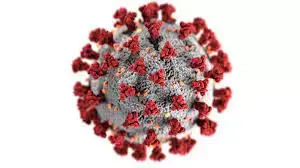People getting the flu shot this year will be vaccinated against three commonly circulating strains instead of four, after one went extinct during the pandemic.
This year’s flu shot will be missing a strain of influenza it’s protected against for more than a decade.
That’s because there have been no confirmed flu cases caused by the Influenza B/Yamagata lineage since spring 2020. And the Food and Drug Administration decided this year that the strain now poses little to no threat to human health.
Scientists have concluded that widespread physical distancing and masking practiced during the early days of COVID-19 appear to have pushed B/Yamagata into oblivion.
This surprised many who study influenza, as it would be the first documented instance of a virus going extinct due to changes in human behavior, said Dr. Rebecca Wurtz, an infectious disease physician and epidemiologist at the University of Minnesota School of Public Health.
“It is such an interesting and unique story,” Wurtz said, adding that if it were not for COVID, B/Yamagata would still be circulating.
One reason COVID mitigation efforts were so effective at eliminating B/Yamagata is there was already a fair amount of immunity in the population against this strain of flu, which was also circulating at a lower level, said Dr. Kawsar Talaat, an infectious disease physician at Johns Hopkins Bloomberg School of Public Health.
In contrast, SARS-CoV-2 was a brand new virus that no one had encountered before; therefore, masking and isolation only slowed its transmission, but did not stop it.
The absence of B/Yamagata won’t change the experience of getting this year’s flu shot, which the Centers for Disease Control and Prevention recommends to everyone over 6 months old. And unvaccinated people are no less likely to get the flu, as B/Victoria and two influenza A lineages are still circulating widely and making people sick. Talaat said the disappearance of B/Yamagata doesn’t appear to have lessened the overall burden of flu, noting that the level of illness that can be attributed to any strain varies from year to year.
The CDC estimates that between 12,000 and 51,000 people die every year from influenza.
However, the manufacturing process is simplified now that the vaccine is trivalent — designed to protect against three flu viruses — instead of quadrivalent, protecting against four. That change allows more doses to be produced, said Talaat.
Ultimately, the costs of continuing to include protection against B/Yamagata in the flu shot outweigh its benefits, said Talaat.
"If you include a strain for which you don't think anybody's going to get infected into a vaccine, there are some potential risks and no potential benefits," she said. "Even though the risks might be infinitesimal, the benefits are also infinitesimal."
Scientists and public health experts have discussed for the past couple years whether to pull B/Yamagata from the flu vaccine or wait for a possible reemergence, said Kevin R. McCarthy, an assistant professor at the University of Pittsburgh's Center for Vaccine Research. But McCarthy agrees that continuing to vaccinate people against B/Yamagata does not benefit public health.
Additionally, there is a slight chance of B/Yamagata accidentally infecting the workers who manufacture the flu vaccine. The viruses, grown in eggs, are inactivated before being put into the shots: You cannot get influenza from the flu shot. But worker exposure to live B/Yamagata might occur before it's rendered harmless.
That hypothetically could lead to a reintroduction of a virus that populations have waning immunity to because B/Yamagata is no longer making people sick. While that risk is very low, McCarthy said it doesn’t make sense to produce thousands of gallons of a likely extinct virus.
It is possible that B/Yamagata continues to exist in pockets of the world that have less comprehensive flu surveillance. However, scientists aren’t worried that it is hiding in animals because humans are the only host population for B lineage flu viruses.
Scientists determined that B/Yamagata disappeared in a relatively short period of time, and this in and of itself is a success, said McCarthy. That required collaboration and data sharing from people all over the world, including countries that the U.S. has more tenuous diplomatic relationships with, like China and Russia.
“I think the fact that we can do that shows that we can get some things right,” he said.


I have not seen that bird in probably over a decade, holy cow
It looks familiar, but I honestly can't remember what it's from?
This was from the ShitRedditSays days, they called it “brd” and I think it was like some mascot for them. I don’t remember much else aside from that
Ah, okay. I thought it was from like a shockwave animation or something.